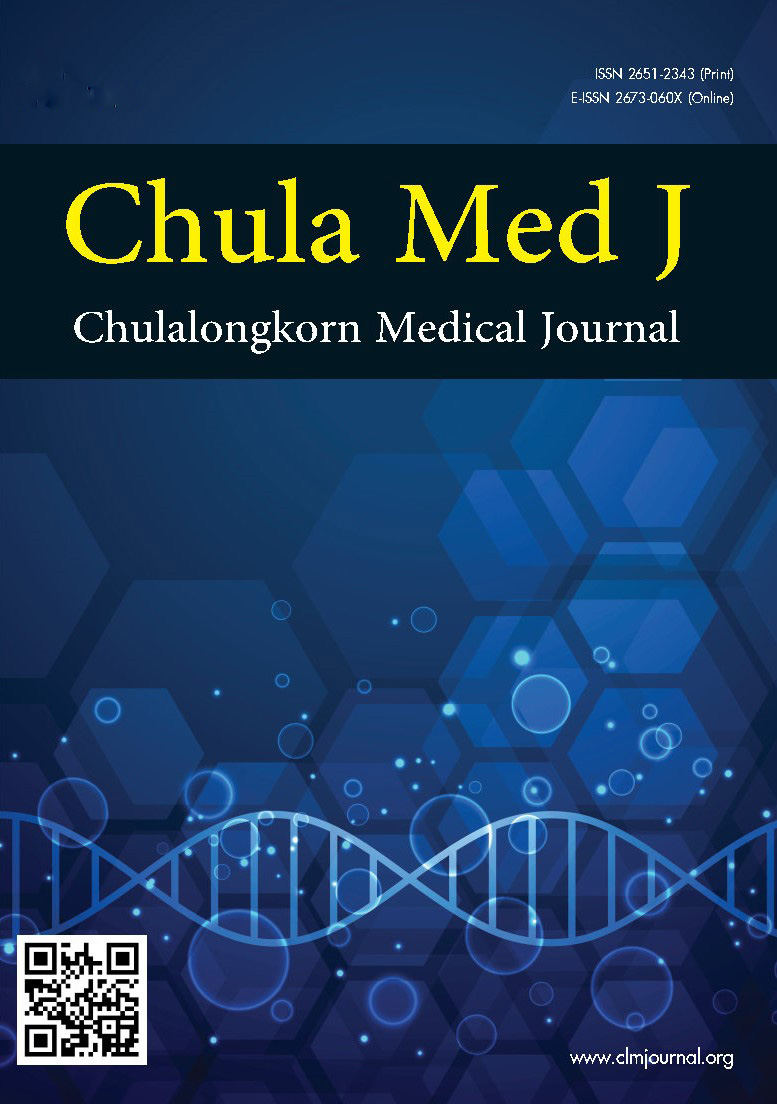Sinonasal anatomical analysis of nonsyndromic bilateral coronal suture craniosynostosis using computed tomography
Keywords:
Children nasal cavity, computed tomography, craniosynostosisAbstract
Background: Craniosynostosis is a skull deformity associated with the premature fusion of one or more cranial sutures. In children with syndromic craniosynostosis, anomalies related to the cranial base and midface contribute to midface hypoplasia, which affects the diameter of the axial facial concavity. Nonsyndromic craniosynostosis, particularly bilateral coronal suture craniosynostosis, may result in abnormal facial proportions and affect sinonasal anatomy.
Objective: This study aimed to determine and analyze morphometric measurement values in the sinonasal cavity of patients with nonsyndromic bilateral coronal suture craniosynostosis.
Methods: This retrospective study analyzed 91 children, aged 0 - 10 years, who underwent computed tomography (CT) at King Chulalongkorn Memorial Hospital between January 2010 and November 2022, including 21 children with nonsyndromic bilateral coronal suture craniosynostosis and 70 controls. The following diameters were measured: anterior bony width (ABW), bony choanal aperture width (BCAW), right posterior bony width (RPBW), and left posterior bony width (LPBW). The study group was further divided into four age groups.
Results: The BCAW, RPBW, and LPBW of the nasal cavity in patients with bilateral coronal suture craniosynostosis, aged 0–12 months, were significantly lower than those of the control group. The RPBW and LPBW in the study group, aged > 72 months, were also significantly lower. All measurements were not dependent on children’s sex.
Conclusion: This study demonstrated that children with nonsyndromic bilateral coronal craniosynostosis exhibited lower diameters of the bony choanal aperture than healthy children.
Downloads
References
Marbate T, Kedia S, Gupta DK. Evaluation and management of nonsyndromic craniosynostosis. J Pediatric Neurosci 2022;17(Suppl 1):S77-91.
https://doi.org/10.4103/jpn.JPN_17_22
Persing JA. MOC-PS (SM) CME article: management considerations in the treatment of craniosynostosis. Plastic Reconstr Surg 2008;121(4 Suppl):1-11.
https://doi.org/10.1097/01.prs.0000305929.40363.bf
Müller-Hagedorn S, Wiechers C, Arand J, Buchenau W, Bacher M, Krimmel M, et al. Less invasive treatment of sleep-disordered breathing in children with syndromic craniosynostosis. Orphanet J Rare Diseases. 2018;13:63.
https://doi.org/10.1186/s13023-018-0808-4
Li W, Khadka A, Hu J, Wang D, Wang Q, Li J. Correction of midface hypoplasia using a novel trapezoidal osteotomy. J Craniofac Surg 2012;23:869-71
https://doi.org/10.1097/SCS.0b013e31824dd5ac
Graham M, Loveridge K, Pollard S, Moore K, Skirko J. Infant midnasal stenosis: Reliability of nasal metrics. AJNR Am J Neuroradiol 2019;40:562-7.
https://doi.org/10.3174/ajnr.A5980
Gruszczyñska K, Likus W, Onyszczuk M, Wawruszczak R, Gołdyn K, Olczak Z, et al. How does nonsyndromic craniosynostosis affect on bone width of nasal cavity in children?- Computed tomography study. Plos one 2018;13:e0200282.
https://doi.org/10.1371/journal.pone.0200282
Tichenor WS, Adinoff A, Smart B, Hamilos DL. Nasal and sinus endoscopy for medical management of resistant rhinosinusitis, including postsurgical patients. J Allergy Clin immunol 2008;121:917-27.e2.
https://doi.org/10.1016/j.jaci.2007.08.065
Cashman EC, MacMahon PJ, Smyth D. Computed tomography scans of paranasal sinuses before functional endoscopic sinus surgery. World J Radiol 2011;3:199-204.
https://doi.org/10.4329/wjr.v3.i8.99
V AM, Santosh B. A study of clinical significance of the depth of olfactory fossa in patients undergoing endoscopic sinus surgery. Indian Journal of Otolaryngology and Head Neck Surg 2017;69:514-22.
https://doi.org/10.1007/s12070-017-1229-8
Kirmi O, Lo SJ, Johnson D, Anslow P. Craniosynostosis: a radiological and surgical perspective. Semin Ultrasound CT MRI 2009;30:492-512.
https://doi.org/10.1053/j.sult.2009.08.002
Albuquerque MA, Cavalcanti MG. Computed tomography assessment of Apert syndrome. Braz Oral Res 2004;18:35-9.
https://doi.org/10.1590/S1806-83242004000100007
Cacciaguerra G, Palermo M, Marino L, Rapisarda FAS, Pavone P, Falsaperla R, et al. The evolution of the role of imaging in the diagnosis of craniosynostosis: a narrative review. Children (Basel) 2021;8:727.
https://doi.org/10.3390/children8090727
Neira JGA, Herazo VDC, Cuenca NTR, Sanabria Cano AM, Sarmiento MFB, Castro MF, et al. Computed tomography findings of Crouzon syndrome: A case report. Radiol Case Rep 2022;17:1288-92.
https://doi.org/10.1016/j.radcr.2022.01.060
Garza RM, Khosla RK. Nonsyndromic craniosynostosis. Semin Plast Surg 2012;26:53-63.
https://doi.org/10.1055/s-0032-1320063
Márquez JC, Herazo Bustos C, Wagner MW. Craniosynostosis: Understanding the misshaped head. RadioGraphics. 2021;41:E45-E6.
https://doi.org/10.1148/rg.2021200127
Faasse M, Mathijssen IMJ, Craniosynostosis ECWGo. Guideline on treatment and management of craniosynostosis: Patient and family version. J Craniofac Surg. 2023;34:418-33.
https://doi.org/10.1097/SCS.0000000000009143
Choi JW, Lim SY, Shin HJ. Craniosynostosis in growing children : Pathophysiological changes and neurosurgical problems. J Korean Neurosurg Soc. 2016;59:197-203.
https://doi.org/10.3340/jkns.2016.59.3.197
Mercan E, Hopper RA, Maga AM. Cranial growth in isolated sagittal craniosynostosis compared with normal growth in the first 6 months of age. J Anat 2020;236:105-16.
https://doi.org/10.1111/joa.13085
Pagnoni M, Fadda MT, Spalice A, Amodeo G, Ursitti F, Mitro V, et al. Surgical timing of craniosynostosis: what to do and when. J Craniomaxillofac Surg 2014;42:513-9.
https://doi.org/10.1016/j.jcms.2013.07.018
Djupesland P, Lyholm B. Changes in nasal airway dimensions in infancy. Acta otolaryngol 1998;118:852-8.
https://doi.org/10.1080/00016489850182576
Musa Ma, Zagga AD, Oon AH. Cranial measurements and pattern of head shapes in children (0-36 months) from Sokoto, Nigeria. Cukurova Med J 2018;43:908-14.
Downloads
Published
How to Cite
Issue
Section
License
Copyright (c) 2024 Chulalongkorn Medical Journal

This work is licensed under a Creative Commons Attribution-NonCommercial-NoDerivatives 4.0 International License.










